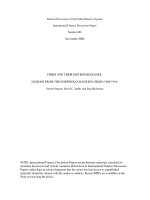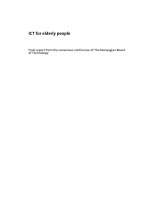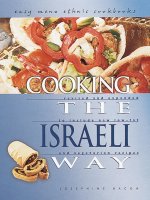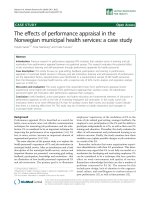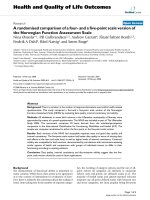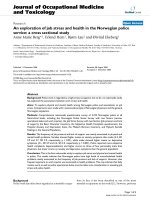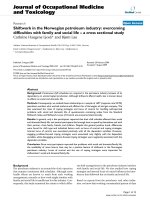cooking the norwegian
Bạn đang xem bản rút gọn của tài liệu. Xem và tải ngay bản đầy đủ của tài liệu tại đây (7.27 MB, 73 trang )
Cooking
t h e
Norwegian
w a y
Copyright © 2002 by Lerner Publications Company
All rights reserved. International copyright secured. No part
of this book may be reproduced, stored in a retrieval system,
or transmitted in any form or by any means—electronic,
mechanical, photocopying, recording, or otherwise—without the prior written permission of Lerner Publications
Company, except for the inclusion of brief quotations in an
acknowledged review.
Lerner Publications Company
A division of Lerner Publishing Group
241 First Avenue North
Minneapolis, MN 55401 U.S.A.
Website address: www.lernerbooks.com
Library of Congress Cataloging-in-Publication Data
Munsen, Sylvia.
Cooking the Norwegian way / by Sylvia Munsen.—Rev. & expanded.
p. cm. — (Easy menu ethnic cookbooks)
Includes index.
Summary: Introduces the land, culture, and cuisine of Norway and
includes recipes for such foods as rice pudding, open-face sandwiches,
and whipped cream cake.
eISBN: 0–8225–0537–1
1. Cookery, Norwegian—Juvenile literature. 2. Norway—Social life
and customs—Juvenile literature. [1. Cookery, Norwegian. 2. Norway—
Social life and customs.] I. Title. II. Series.
TX722.N6 M86 2002
641.59481—dc21
2001003276
Manufactured in the United States of America
1 2 3 4 5 6 – AM – 07 06 05 04 03 02
easy
menu
ethnic
cookbooks
Cooking
r e v i s e d
a n d
e x p a n d e d
t h e
t o
i n c l u d e
n e w
l o w - f a t
NORWEGIAN
a n d
v e g e t a r i a n
r e c i p e s
w a y
Sylvia Munsen
a Lerner Publications Company • Minneapolis
Contents
INTRODUCTION, 7
A NORWEGIAN TABLE, 27
The Land and Its People, 8
The Food, 9
Holidays and Festivals, 13
A Norwegian Menu, 28
BEFORE YOU BEGIN, 19
The Careful Cook, 20
Cooking Utensils, 21
Cooking Terms, 21
Special Ingredients, 22
Healthy and Low-Fat Cooking Tips, 24
Metric Conversions Chart, 25
LUNCH, 31
Open-Face Sandwiches, 32
Potato Soup, 34
SNACKs, 37
Flatbread, 38
Waffles, 40
DINNER, 43
HOLIDAY AND
Poached Salmon, 44
Boiled Potatoes, 45
Baked Cod, 46
Meatcakes, 49
Mashed Rutabagas, 50
Cucumber Salad, 51
Beet Patties, 52
Fruit Soup, 55
Whipped Cream Cake, 56
FESTIVAL FOOD, 59
Smoked Salmon Quiche, 60
Sour Cream Porridge, 63
Christmas Bread, 64
Gingerbread Cookies, 66
Raspberry Sauce, 68
Rice Pudding, 69
INDEX, 70
Introduction
Norwegian cooking has been shaped by the country’s landscape,
climate, and natural resources. Coastal waters provide ample fish, a
staple of the Norwegian diet. The many hours of light during sum
mer allow for a slow ripening of berries and fruits, giving them a
special flavor. Sheep graze in the mountains, providing meat that
can be eaten fresh or dried, cured, and preserved for the very long
winter. Cows produce milk, “the mother of all dishes” in Norway.
Some Norwegian dishes, such as boiled potatoes and baked fish,
are familiar. Other foods are not as well known outside Norway, but
they are tasty to eat and easy to make. Once you know about some
of the foods and customs, you’ll want to try making your own
Norwegian meals. Then you can go on to the best part—eating!
Norwegians enjoy using fresh fruits for tasty treats such as whipped cream cake.
(Recipe on page 56.)
7
A rc
ti c
C ir
RUSSIA
cle
KJ
ØL
EN
M
OU
NT
AI
NS
Norwegian
Sea
·
SWEDEN
Trondheim
Gulf
of
Bothnia
sognefjord
NORWAY
·
Bergen
Oslo
Baltic
Sea
FINLAND
North
Sea
The Land and Its People
Norway remains a land of unspoiled natural beauty. Perched atop the
globe, the long, narrow country stretches about 1,100 miles from
north to south but is often no more than 60 miles wide from east
to west. Steep, jagged fjords, salmon-filled rivers, plummeting
waterfalls, snow-crested mountains, miles of coast, and green mead
ows and farmland create a varied and dramatic landscape.
8
Water has always affected Norway’s history and culture. This is
because about two-thirds of Norway is surrounded by the sea, and
hundreds of fjords jut inland along the coast. A fjord is an arm of the
sea that reaches into the mountains. Some fjords are many miles
long—the longest, Sognefjord, stretches about 125 miles. Since
most of Norway is rocky and mountainous, Norwegians depend on
the fjords and the sea for both transportation and food.
Farming is also important in Norway, even though only about 5
percent of the land can be used to grow crops. Family farms in
Norway are small. But the livestock, grains, vegetables, and fruits
raised in Norway form the major staples of the Norwegian diet.
The northern part of Norway, called the “land of the midnight
sun,” lies above the Arctic Circle. In the summer, the sun shines
twenty-four hours a day, followed by twenty-four hours of darkness
in winter. Even in southern Norway, summer days are long and win
ter nights last more than seventeen hours.
Norway is a modern, technologically advanced country, but
Norwegians are also deeply attached to nature. People of all ages
spend as much time as possible outdoors, skiing, hiking, fishing,
and biking, and city dwellers escape to their cabins in the wilderness
whenever possible.
The Food
Norwegian farmers grow rye, wheat, and barley on their small
amount of available land. These grains are used to make many kinds
of bread. Farmers also raise sheep, goats, pigs, and dairy cattle,
which provide mutton, lamb, and pork, as well as the cheeses that
Norwegians enjoy. Two special Norwegian cheeses are geitost, which
is made from goat’s milk, and gammelost, a tangy brown cheese made
from soured skim milk.
Fruits and vegetables are other products grown in Norway. This
may seem odd, since one-third of the country lies above the Arctic
9
Circle. But the warm Gulf Stream currents and mild southwesterly
winds keep the average temperature in Norway higher than that of
other northern lands.
Norway is cool and damp during the growing season. Vegetables
that grow well in this climate are potatoes, carrots, cauliflower, cab
bage, peas, and rutabagas. A Norwegian dinner often includes pota
toes, especially boiled potatoes. Novelist Knut Hamsun paid tribute
to the prominent place of the potato in Norway, writing, “A man
may be without bread, but if he has the potato he will not starve.”
At least twelve different kinds of potatoes grow in Norway.
Many kinds of berries thrive in Norway, including strawberries,
blueberries, lingonberries (also known as mountain cranberries),
and cloudberries. Cloudberries are bright orange and shaped like
raspberries. They are called cloudberries because they grow in the
mountains, “near the clouds.” They are sometimes mixed with
cream in a dish called multekrem.
Because they live so close to the sea, Norwegians eat a lot of fish.
The waters surrounding Norway are rich with torsk (cod), herring,
pollack, haddock, mackerel, and other types of fish. Salmon is abun
dant in the rivers along the coast and is also raised on fish farms.
Norway is one of the world’s leading producers of salmon, which is
exported to Europe and the United States.
In the summer, Norwegians can buy fresh fish daily at the out
door fish markets. The most plentiful fish in the markets is torsk,
which is practically the national fish of Norway. It is called “poor
man’s lobster.”
In the days before refrigerators and freezers existed, Norwegians
needed to find ways to store fish and meat for the long winter. They
preserved fish and meat in a number of ways—drying, salting, cur
ing, pickling, and smoking. Although people no longer rely on cured
and dried meats and fish for survival, they are still a popular part of
Norwegian cuisine. Dried cod that is soaked in water and lye is
called lutefisk. Some Norwegians consider lutefisk a delicacy, while
others hate it!
10
Image Not Available
Although fish is important in Norway, Norwegian cooking
is known for its use of many different types of food.The Vikings (A.D.
700 to A.D. 1000), the early seafaring Norwegian explorers,
are said to have started the smorgasbord, a buffet of a wide variety
of dishes.
11
Image Not Available
According to legend, the Vikings always brought back a variety of
foods from their voyages. But they never brought enough for every
body to have a full helping, so people at home only got a small taste
of each food. A typical smorgasbord includes many kinds of fish,
cold sliced meats, cheeses, vegetables, salads, breads, and a hot dish
such as meatballs or meatcakes. Dessert may be fresh fruit, cold fruit
soup, or rice pudding. Buffets such as these are often served in hotels
and restaurants.
One of the oldest Norwegian food dishes is porridge. Until the
mid-1800s, Norwegians ate porridge twice or even three times a
day. An old tale from Telemark, a southern province of Norway, says
12
that each woman in the area was asked if she could make porridge.
If the answer was “No,” she was told, “You may as well pack up.” In
other words, if you couldn’t make porridge, you were of no use!
Ordinary porridge, such as rice porridge, may be eaten for break
fast. A richer porridge called rømmegrøt, made with flour and sour
cream, is eaten for holiday meals and family celebrations.
Holidays and Festivals
Like the foods in Norway, holidays and festivals reflect the cycles of
nature. “We use our holidays to celebrate the sun,” wrote Norwegian
author and explorer Thor Heyerdahl. “We celebrate the arrival of the
sun, the summer solstice, we journey to the mountains in search of
the sun, and on the day we miss it most, because it is farthest away,
we cheer ourselves with a grand Christmas feast.”
In ancient times, a midwinter feast, called Jul in Norwegian, was
a festival of lights to mark the transition from the dark winter to
spring and summer. It was a time to celebrate the harvest and the
cycles of birth and death. Starting about A.D. 1000, the yearly feast
was turned into a Christian holiday, Christmas, marking the birth of
Jesus. Some of the ancient traditions, such as the feasting and the
lights, live on in the modern holiday.
Preparations begin for Christmas throughout Norway in
December. A special Christmas beer, juleøl, is brewed, people do their
Christmas shopping, and families and friends get together to cele
brate at work, home, and school. In many homes, an enticing spicy
aroma fills the air as families bake the traditional seven types of
Christmas cookies, along with julekake, sweet Christmas bread.
Christmas trees are decorated with white lights or candles, tinsel,
small Norwegian flags, wood or straw ornaments, and colorful
heart-shaped paper baskets. Children make these paper baskets,
which are often filled with nuts, fruits, and other goodies. Many
kids also hang up stockings.
13
The main festivities happen on Christmas Eve, December 24.
Christmas dinner foods differ from one part of the country to
another. In the coastal areas and in northern Norway, people eat cod,
halibut, or lutefisk. In the eastern part of the country, pork ribs,
sausages, and patties are on the menu, while people in western
Norway prefer pinnekjøtt, salted lamb ribs. More and more
Norwegians are turning to turkey, which is not as common in
Norway as in other countries.
Many families have a bowl of porridge or rice pudding on
Christmas Eve. An almond is hidden in the pudding, and whoever
finds it gets a reward, usually a pig made of marzipan (sweet
almond paste) or a piece of chocolate. That person is also supposed
to have good luck and happiness in the new year. In other families,
the person who gets the almond is in charge of the ceremonies on
Christmas Eve.
An old tradition is to leave out a bowl of porridge for the nisse, a
gnome or elf who was said to protect the farm. The nisse would be
helpful as long as he got his Christmas porridge—if not, he might
cause trouble. There’s also the julenissen, or Christmas gnome, sort of
like a Norwegian Santa Claus. The julenissen has a long white beard
and wears a red stocking cap, knee-length britches, and a
Norwegian sweater. The julenissen hands out presents to the chil
dren on Christmas Eve.
After dinner, the family joins hands and walks around the
Christmas tree, singing carols. The presents are opened, and as the
kids play with their new toys, the adults enjoy coffee and Christmas
cookies.
On Christmas Day, Norwegians typically prepare a smorgasbord,
with foods such as ham, herring in tomato sauce, sausages, pork pat
ties, salads, and desserts. In many parts of the country, lobster is
served for breakfast.
Easter in Norway, besides being a religious holiday, is a celebra
tion of solitude, a time to “commune with nature.” Even though
snow still covers the ground, the days are getting longer and the sun
14
Image Not Available
is stronger. Many Norwegians are off work for the week between
Palm Sunday and Easter, and they go to the mountains to ski and stay
in a cabin.
The true celebration of spring takes place on May 17, called
Syttende Mai, or Constitution Day—the most important holiday in
Norway. The day marks the anniversary of the country’s declaration
of independence from Denmark in 1814, when Norwegian elected
officials signed a new constitution.
May 17 is a day of flags, parades, speeches, and bands playing the
national anthem. Norwegians everywhere carry flags and wear the
embroidered national costume. In Oslo the highlight of the day is
15
Image Not Available
the children’s parade, when thousands of schoolchildren, waving
flags and banners, march past the Royal Palace in salute to the king.
After the parade, local communities celebrate with speeches, games
and contests, bands, and local parades. At night, people join friends
or neighbors for parties.
16
Food on Constitution Day might include hot dogs and ice cream
as well as the traditional holiday food, rømmegrøt (sour cream por
ridge). Many people also enjoy a glass of eggnog on May 17. At this
early point in spring, the only fruit in season is rhubarb, so some
people make a dessert with rhubarb—or buy a cake from the bakery.
The peak of summer is celebrated on Midsummer Eve, June 23.
This festival marks the summer solstice, when the days are longest
and the nights are light. All over the country, people make bonfires,
barbecue, and party with friends. People might decorate their homes
with birch branches and freshly cut flowers. Once again, rømmegrøt
is on the menu.
A final summer festival, Olsok, or Saint Olav’s Day, takes place on
July 29. Olsok commemorates King Olav Haraldsson, one of
Norway’s earliest kings. On Saint Olav’s Day, the city of Trondheim
holds a Saint Olav Festival, and in nearby Stiklestad, where Olav
died, thousands of visitors attend the Legend of Saint Olav, an out
door play in which 300 actors, a choir, and an orchestra reenact the
battle that took place there almost one thousand years ago.
17
Before You Begin
Cooking any dish, plain or fancy, is easier and more fun if you are
familiar with its ingredients. Norwegian cooking makes use of some
ingredients that you may not know. Sometimes special cookware is
also used, although the recipes in this book can easily be prepared
with ordinary utensils and pans.
The most important thing you need to know before you start is
how to be a careful cook. On the following page, you’ll find a few
rules that will make your cooking experience safe, fun, and easy.
Next, take a look at the “dictionary” of cooking utensils, terms, and
special ingredients. You may also want to read the suggestions for
preparing healthy, low-fat meals.
Once you’ve picked out a recipe to try, read through it from
beginning to end. Now you are ready to shop for ingredients and to
organize the cookware you will need. When you have assembled
everything, you’re ready to begin cooking.
Cucumber salad combines paper-thin slices of cucumber with tangy vinegar and
fresh herbs. (Recipe on page 51.)
19
The Careful Cook
Whenever you cook, there are certain safety rules you must
always keep in mind. Even experienced cooks follow these rules
when they are in the kitchen.
• Always wash your hands before handling food. Thoroughly
wash all raw vegetables and fruits to remove dirt, chemicals,
and insecticides. Wash uncooked poultry, fish, and meat under
cold water.
• Use a cutting board when cutting up vegetables and fruits.
Don’t cut them up in your hand! And be sure to cut in a
direction away from you and your fingers.
• Long hair or loose clothing can easily catch fire if brought
near the burners of a stove. If you have long hair, tie it back
before you start cooking.
• Turn all pot handles toward the back of the stove so that
you will not catch your sleeves or jewelry on them. This is
especially important when younger brothers and sisters are
around. They could easily knock off a pot and get burned.
• Always use a pot holder to steady hot pots or to take pans out
of the oven. Don’t use a wet cloth on a hot pan because the
steam it produces could burn you.
• Lift the lid of a steaming pot with the opening away from you
so that you will not get burned.
• If you get burned, hold the burn under cold running water.
Do not put grease or butter on it. Cold water helps to take the
heat out, but grease or butter will only keep it in.
• If grease or cooking oil catches fire, throw baking soda or
salt at the bottom of the flame to put it out. (Water will not
put out a grease fire.) Call for help, and try to turn all the
stove burners to “off.”
20
Cooking Utensils
cheese slicer—A flat metal utensil somewhat like a spatula with a sharp
edge through the middle, used for cutting very thin slices of cheese
food processor—An electric appliance with a blade that revolves inside a
container to chop, mix, or blend food
slotted spoon—A large spoon with holes in it to allow liquid to drain
waffle iron—An electric appliance with two metal parts that shut onto
each other, pressing the waffle batter into a certain shape and cook
ing it. Norwegian waffle irons create five heart-shaped waffles.
whisk—A wire utensil used for beating food by hand
Cooking Terms
blanch—To partially cook a food in boiling water for a short time; also
called parboil
boil—To heat a liquid over high heat until bubbles form and rise rap
idly to the surface
brown—To cook food quickly in fat over high heat so that the surface
turns an even brown
cream—To blend two or more ingredients (such as butter and sugar)
together until the mixture has a creamy consistency
fold—To blend an ingredient with other ingredients by using a gentle
overturning circular motion instead of by stirring or beating
hard cook—To boil an egg in its shell until both the yolk and white are
firm
knead—To work dough by pressing it with the palms, pushing it out
ward and then pressing it over on itself
poach—To cook in a simmering liquid
21
preheat—To allow an oven to warm up to a certain temperature before
putting food in it
sauté—To fry quickly over high heat in oil or fat, stirring or turning
the food to prevent burning
scald—To heat a liquid (such as milk) to a temperature just below its
boiling point
shred—To tear or cut food into small pieces, either by hand or with a
grater
simmer—To cook over low heat in liquid kept just below its boiling
point. Bubbles may occasionally rise to the surface.
steep—To soak in a liquid
Special Ingredients
agar-agar—A thickening agent made from sea vegetables
bay leaf—The dried leaf of the bay (also called laurel) tree. It is used to
season food.
buttermilk—A milk product made from soured milk
candied fruit—Fruit that is encrusted with sugar or syrup
cardamom seed—A spice from the ginger family, either whole or
ground, that has a rich color and gives food a sweet, cool taste
CHEESES
gammelost—A tangy brown cheese made from soured skim milk
geitost—A brown cheese made from goat’s milk
Norwegian—A mild cheese that is similar to Gouda
chive—A plant that is related to onions and is used as a seasoning
cornmeal—A meal made from ground corn
22
cornstarch—A fine white starch made from corn, commonly used to
thicken sauces and gravies
dill—An herb whose seeds and leaves (called dill weed) are both used
in cooking. The flavor of the leaves is similar to that of parsley, and
the flavor of the seeds resembles caraway seed.
gelatin—A clear, powdered protein substance used as a thickening agent
ginger—A spicy seasoning made from the dried and ground stem of a
tropical herb
nutmeg—A fragrant spice, either whole or ground, that is often used in
desserts
paprika—A red seasoning made from ground, dried pods of the cap
sicum pepper plant
peppercorns—The dried whole berries of a tropical vine, which are
ground to form black and white pepper. Green peppercorns are the
unripened berry, black peppercorns are dried, and white pepper
corns are ripened and processed.
potato flour—A flour made from potatoes that have been cooked, dried,
and ground. This flour is mainly used in gravies, breads, and cakes.
rutabaga—A yellow-fleshed root vegetable
smoked salmon—Raw salmon that has been preserved by exposure to smoke
stone-ground whole wheat flour—A flour from wheat that is ground under
a millstone. It is called whole wheat because the bran is not
removed from the grain.
tapioca—The roasted and ground root of the tropical cassava plant,
used as a thickener or eaten as a pudding
white pepper—A seasoning made from ground peppercorns.White pepper
is used when black pepper would make the food look less appealing.
yeast—An ingredient used in baking that causes dough to rise and
become light and fluffy. Yeast is available either in small, white cakes
called compressed yeast or in granular form called active dry yeast.
23
Healthy and Low-Fat
Cooking Tips
Many cooks are concerned about preparing healthy, low-fat meals.
Fortunately, there are simple ways to reduce the fat content of most
dishes. Here are a few general tips for adapting the recipes in this
book. Throughout the book, you’ll also find specific suggestions for
individual recipes—and don’t worry, they’ll still taste delicious!
Many Norwegian recipes call for butter. Using oil lowers saturated
fat, but you can also reduce the amount of oil you use. Sprinkling a
little salt on fish or vegetables brings out their natural juices, so less
oil is needed. It’s also a good idea to use a nonstick frying pan if you
decide to use less oil than the recipe calls for.
Another common substitution for butter is margarine. Before
making this substitution, consider the recipe. If it is a dessert, it’s
often best to use butter. Margarine may noticeably change the taste
or consistency of the food.
Other dairy products, such as cream, milk, and sour cream, are
also common in Norwegian cooking. An easy way to trim fat from a
recipe is to use skim or evaporated skim milk in place of cream,
whole milk, or 2 percent milk. In recipes that require sour cream,
you may be able to substitute low-fat or nonfat sour cream, but
lower-fat sour cream may change the consistency or taste of the
food. Another possible substitution for sour cream is nonfat plain
yogurt.
When a recipe calls for meat, such as sliced ham or ground beef,
buy extra-lean meat to reduce fat. Norwegian cooking uses a lot of
fish, which is naturally low in fat.
There are many ways to prepare meals that are good for you and
still taste great. As you become a more experienced cook, try exper
imenting with recipes and substitutions to find the methods that
work best for you.
24

